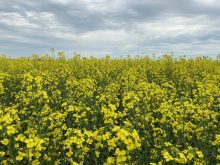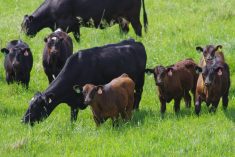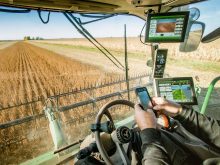One-time pulse growers across Alberta all seem to say the same thing when asked about their experience with pulse crops, “I tried peas once, and never will again.”
Though Alberta pulse acres have grown steadily over the past five years, field peas have earned a reputation as being more work than they’re worth at harvest time. For many growers, improved varieties, strong prices, and reduced input costs have not yet proven enough incentive to lure growers away from their tight rotations of crops that are comparatively simple to grow.
Read Also

An unbelievable tale of a lost engagement ring
After nearly 50 years, a southern Alberta farmer finds her wedding ring in an unusual place.
But Leanne Fischbuch, executive director of Alberta Pulse Growers, says pulses have a lot of potential.
“If we can grow a domestic industry and use the product — whether whole or as an ingredient — in Canada, that would be a really positive breakthrough for the industry,” she said.
In Alberta, pulse crop acres — which include field pea, dry bean, lentil, chickpea, faba bean, and soybean — account for around five per cent of the arable land in the province. The pulse industry would like to see that grow to 15 per cent — a lofty goal that will depend both on improved varieties and improved domestic processing capacity.
Without improved varieties, however, improved processing capacity becomes almost a moot point, says Sheri Strydhorst, agronomy research scientist with Alberta Agriculture. “Processing capacity is a real issue, but if we can’t grow it and grow it well, we’re not going to have anything to process,” said Strydhorst. “If the price of peas were to double, I’m sure pea acres would follow. Given that that’s not realistic right now, making them a more friendly crop to grow would make a tremendous advancement.”
Other options
For those growers who don’t want to give peas a second chance, emerging pulse types may prove to be a viable option in rotations that are missing a nitrogen-fixing crop.
Faba bean is one such crop. Over the past year, faba acres in Alberta have almost tripled, from around 5,000 in 2012 to around 15,000 in 2013. Strydhorst credits the growth in acres to increased market opportunities. “Having somewhere viable to sell into has certainly helped faba bean production grow in the province,” she said.
Blair Roth, Viterra’s director of special crops, says improving agronomic knowledge for fabas could help to increase marketing options.
“There’s some good work going on agronomically, and I think we need to understand that more as we try to grow the faba bean marketplace.”
Seed quality has been a marketing concern for fabas in the past, and that hasn’t changed.
“The challenge with faba beans is finding the right genetic types that work within various parts of Alberta and then growing the qualities required by specific markets,” said Roth. “Today, Egypt is probably one of the largest importers of fabas in the world, but our challenge is growing the appropriate quality to hit that marketplace.”
Though fabas are generally exported for human consumption or used for feed, Alberta Pulse Growers sees significant potential for faba beans in the ingredient market.
“If we could break the faba bean into its various fractions — protein, fibre, and starch — we should be able to develop markets for use of those products,” said Fischbuch. “Seeing that part of the sector develop would be a real bonus for the pulse industry.”
Soys need heat
Soybeans have also drummed up some interest in the past year, but so far, southern Alberta growers seem to be having the most success with them.
“Soybeans could be an option in some parts of the province, but for most of Alberta, I don’t think the breeding is there yet,” said Strydhorst.
This year’s pulse Regional Variety Trials will evaluate soybean variety performance across Alberta for the first time, a move supported by Alberta Pulse Growers. “There’s a ways to go yet in terms of the development of soybeans for our growers and for use in the province as a cropping option, but it’s certainly on our radar,” said Fischbuch. “All we need to do is look over to Manitoba and see what’s happened there as a potential precursor of what could happen here in time.”
While work is still needed on both established and emerging pulse types, Strydhorst says that no matter which type a producer chooses to grow, pulse crops are a vital part of a sustainable cropping system. “Although pulses can have their headaches, what they offer in terms of the overall health of the system, environmental sustainability, and diversifying the cropping system both biologically and economically is unlike any other crop.”














